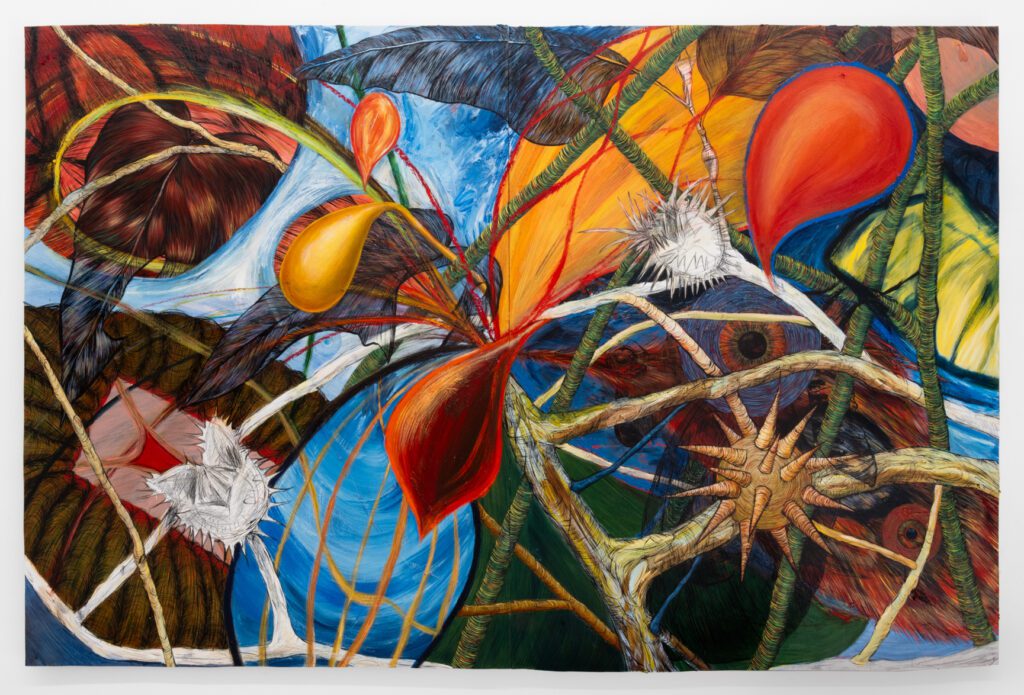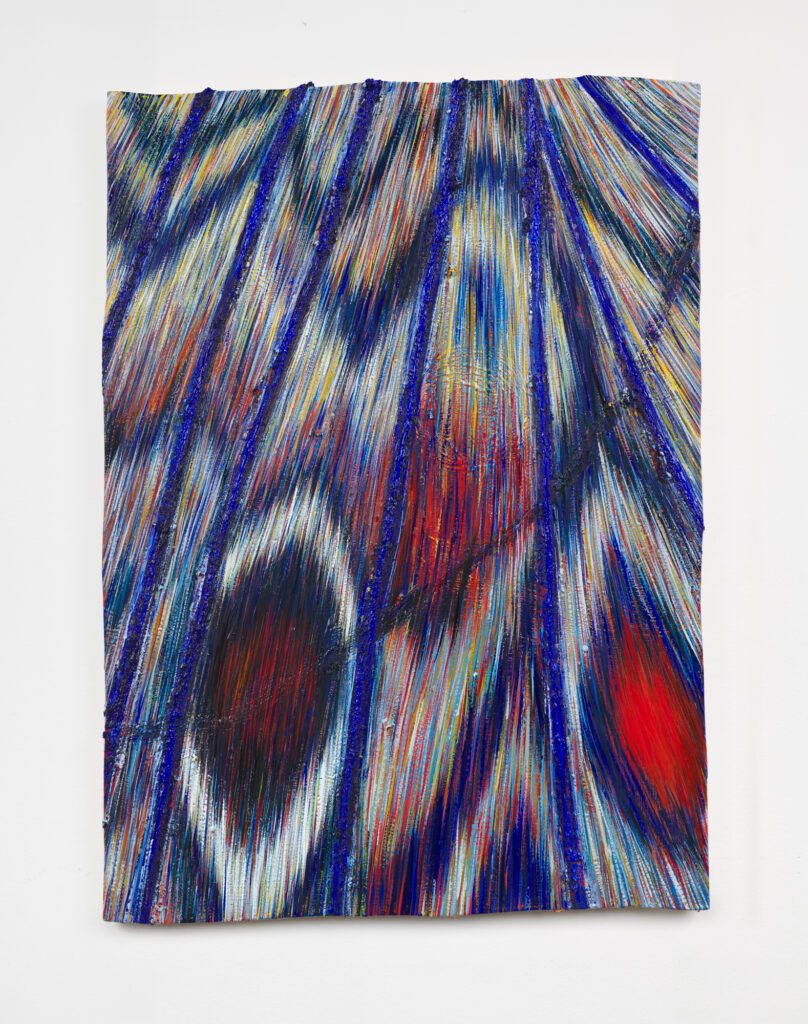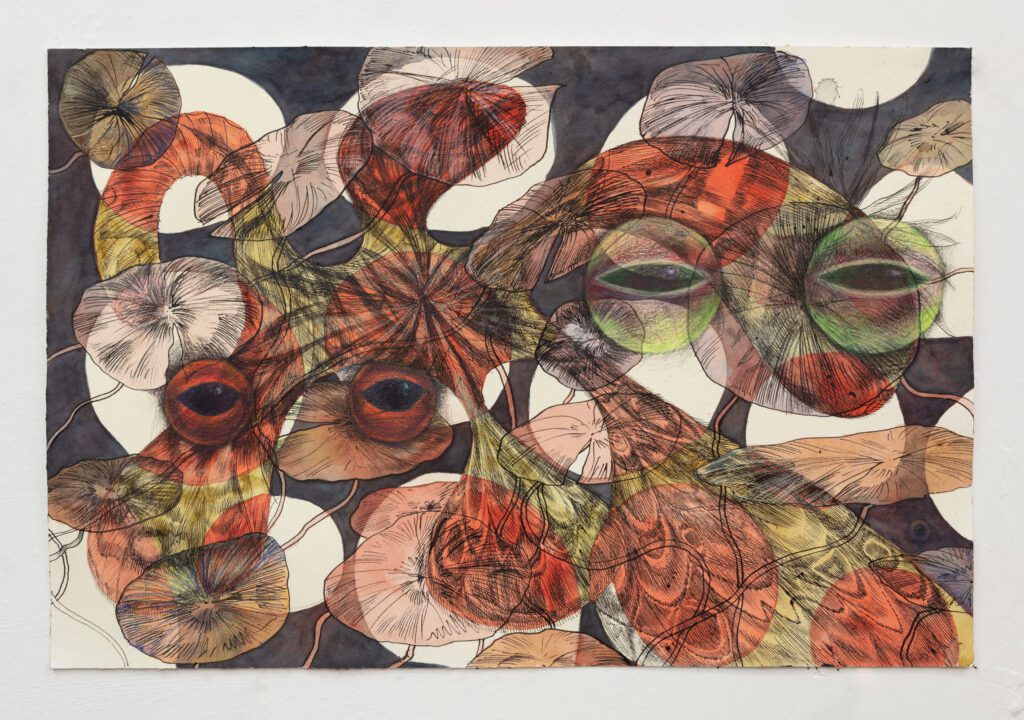Camouflage, Transformative Goo, and Transness: In Conversation with Sarah Davidson
4 November 2025By Jay Pahre

I first met Sarah Davidson during a queer ecology-themed Banff Centre residency in 2022, where we bonded over our love of hiking, literature, and our mutual interests in queerness beyond the human variety. Throughout our time there, we spent many days out of the studio walking up various mountains and talking about drawing, writing, and being trans in different spaces. Davidson’s practice exists within the genres of painting and drawing, and weaves figurative elements of the natural world together with a rigorous illustrative hand that blends into colourful biomorphic abstraction, complicating the boundaries between bodies, organisms, and forms. This conversation took place in the spring of 2025, while their solo exhibition, Blending In, was on view at Auxier Kline in New York, as well as a group show called Sympathetic Lightning, which was co-curated by Davidson and Nirvana Santos-Kuilan at Springs Projects. My work was included in Sympathetic Lightning, though myself and several other artists in the show were unable to visit the show in the US due to shifting policies around transness and identification at the border. Davidson and I recently joined in conversation to reflect on how understandings of transness and queerness have shifted in the last several years, what art can offer in these re/interpretations, and how in these times, looking for survival strategies from the more-than-human is more resonant than ever.
Jay Pahre: How are you?
Sarah Davidson: I’m okay. You know, the micro world is okay, the macro world is more complex. I’ve been closely following what’s going on with passports for trans people in the United States, but it really just hit me when we were chatting recently and you said that you couldn’t come for the opening of our exhibition––that half of the artists in the group show probably weren’t going to be able travel to New York. It’s not at all what I had in mind when I first started putting it together a year ago. The show reflects my own research, and includes work by nine artists who variously expand understandings of ‘nature’ through themes of haunting, dislocation, and non-linear time, from queer or trans perspectives.
Anyway, since we spoke, trans people’s travel challenges have become a part of the theme for the exhibition: my co-curator Nirvana came up with the title Sympathetic Lightning, a scientific term which has to do with lightning having a tendency to strike in disparate places at the same time. These remote electrical events are a metaphor for how the artists are working in parallel ways from different geographical places (and themes of time and dislocation appear in the works). Also, lightning has all these bodily associations. It looks like veins or nerves and, depending on your distance from the storm, you experience the visual side of lightning many seconds before you hear the audio of thunder, which is a very odd, dislocating phenomenon.
JP: That’s wonderful, and has great resonance with how this show is a collection of queer and trans artists working and thinking through intersections of queerness, transness, and beyond-human thinking at this current political moment. I was really interested in lightning when I was working on the copper pieces that I was making a few years ago, there’s been some strong associations with lightning, anticipation, transness, and the more-than-human/beyond-human. There’s this brilliant essay that Karen Barad wrote about lightning and transness. One of the things that stuck with me, and has continued to inform my practice, which I’m also seeing as strongly connected to this exhibition, was how lightning actually reaches up from the ground before it reaches down from the sky. So it’s always anticipating itself before it arrives, both spatially and temporarily. To have this group of trans and queer artists working like lightning, across time and space, on connected issues, feels deeply resonant right now. We’re living in complex times, politically, ecologically, and otherwise, but I feel like sometimes the times tell you what the thing actually is that we’re all resonating around.

SD: I can’t remember who it was, but another artist was posting on the internet the other day that this moment will herald a return to queer abstraction, alongside a picture of Félix González-Torres’ work. And I think on one hand, of course, now’s the time to evade and use coded ways of articulating our position. But it also makes me sad that we’re experiencing a chill on political speech. By chill I mean self-censorship for fear of backlash, in the artworld and beyond. For example, there was a very recent controversy about curators omitting key context from the wall label about González-Torres’ work “Untitled” (Portrait of Ross in L.A.) at the National Portrait Gallery in Washington, D.C. While they specified that the ‘ideal weight’ of the work was 175 pounds, they omitted the fact that this referred to the healthy weight of the artists’ partner, who at the time was dying of AIDS. Without this information, it arguably just becomes a pile of free candy.
JP: But it’s also about us finding another way to think about our own representation, and what we want and desire, and what we want to be intelligible.
SD: Right, queer people have always made political art and it hasn’t always been obvious to people who weren’t in the know. But that’s the thing, what is the capacity of abstraction to talk about queerness? It’s a working question for me, and I feel a bit conflicted about it, as someone who’s coming from more of a representational background. I use elements of biomorphic abstraction in my paintings, but to my mind it’s never totally abstract, because there are recognizable things in it.
JP: So I was thinking about your work, because you’re thinking about this moment of transformation butterflies and moths go through. Butterflies’ and moths’ bodies disintegrate into goo during their transformation, and so that’s this moment where the abstraction actually is representational, or the representational is interpreted as abstraction.
SD: I hadn’t thought of that…but the way I’m thinking about abstraction when I’m coming up with the forms in my paintings is always in relation to the body. They’re not meant to just exist in this realm that’s outside of lived, embodied, unique experience. For me abstraction is never strictly formal. I’m using these blobby interruptions in the work as a way of pointing towards the grotesque and complicating the digestibility of just looking at recognizable flora and fauna. It’s meant to link things to the body and disrupt the uniformity of the composition. I arrived at what I’m making now from thinking about ‘natural history’ and the way that we’ve been taught to understand so-called ‘nature.’ There’s so much in the history of observing nature that has to do with defining what’s natural and what isn’t (which has been used against us at many points in history). I’m interested in dissolving that distinction. I was thinking about histories of biological illustration, and how that fraught history was the subject, but I wasn’t really thinking about my practice so much in terms of my own queer and trans lived experience of the world, until the pandemic.
At first, I was using butterflies and moths as a way of putting eyeballs in the work, because I thought it would be uncanny if the ‘nature’ looked back at the viewer. Moths and butterflies have eye patterns on their wings, it was an interesting thing to play with. But then after making all these drawings for two years (between 2020-2022) I realized there was more at stake in it for me. It was also during the time where I was coming to terms with being trans, transitioning socially, and rethinking so many things about how I see and experience the world, and how people experience and react to me. I can’t not see that series of drawings in relation to that experience, because it was all so tied together during that time. So there’s something in there that embodies the experience of moving through the world as a queer and trans person.
JP: It’s super rich visually and conceptually, everything gets very enmeshed and interwoven. Something I’m thinking about too is how these butterflies and moths have developed these eye patterns as a response to threat. The threat of being eaten or being killed caused them to develop these patterns on their wings that look like something staring back. With what’s happening politically in the world, it puts the transness and queerness relationship in an interesting position.
SD: I think there’s so much about being seen that’s very fraught. In the history of ‘nature,’ to be seen is often to be forced into a system of understanding that you might not have any stake in. In terms of the queer experience, being seen is a double edged sword. There’s a power in it, but also a threat. What’s interesting about the eyeballs for me is that they exist in that ambiguous zone.
JP: It’s an interesting bundling together of different kinds of refusals: refusing to be seen, refusing to be interpreted in a way that’s easy; but also, the reversal of this pattern. It doesn’t quite reverse the gaze, it doesn’t quite evade the gaze, but it kind of highlights the act of looking, and highlights the act of what that generates, as far as a bodily response.

SD: I mean something else I’ve been thinking about is camouflage. I named a work after it actually: Crypsis (the scientific term). Compositionally, I’m playing with patterns and the way things blend into each other. I want elements of the work to emerge slowly. The longer you look, the more you realize there are details hidden in the paintings, and things connect in surprising ways: a wing pattern is overlaid over another shape, but then the outline of that shape pierces through the wing and links it into something else surprising. Camouflage can also be an evasive strategy: as queer and trans people, we get very used to code switching, figuring out how to suss out environments and assess whether they’re safe and whether it’s okay to be seen. Camouflage can also do this subversive thing of drawing you in, only for you to realize you’re not looking at what you thought you were.
JP: That evasive strategy is definitely a familiar experience for me. It’s a different kind of perspective on how you’re reading space or reading the environment, scanning for threats, and deciding how much to blend in or stick out. I think camouflage is an interesting way of talking about that sort of experience. I was thinking about that in my own work, Space Blanket (2019-ongoing), which is included in Sympathetic Lightning (the show that you and Nirvana curated). Space Blanket is a work that’s made of testosterone gel packets, which are cut open and then stitched together into a large quilt. The exterior looks like an emergency blanket, one of those single-use, highly reflective blankets used for emergency shelter and warmth in the backcountry, or for treating people in shock after a disaster or a marathon. In this artwork, there’s a relationship with camouflage, emergency response, safety, transformation, and visibility. As an object, a space blanket obscures the wearer by reflecting the world around them. I see this as coming at camouflage in a resonating, but distinct vein from your own work. There’s so much that can be said about how, where, and when we camouflage, and the intelligibility of that act in different contexts.
I really like what you said about code switching and how that’s kind of an ongoing practice. I can’t speak for everyone, but I’m guessing for many people that it’s an everyday habit, that it happens multiple times and in different contexts, constantly. And so it’s this really interesting navigation of the subject, both being the camouflage and camouflaging. It’s an interesting context for transness and queerness as well, because that orientation of self is always changing.

SD: One of the things I think of too, in relation to Space Blanket, is that it reminds me of Félix González-Torres’s work. Both in that it appears very formal and elegant, and also in that it’s actually an ongoing performance: you continue to stitch testosterone gel packets to the blanket as you use them. It’s so much about your own body and life, and ongoingness. But it takes close looking, and knowing a bit of context, for a viewer to understand that.
To return to what you were saying a moment ago, about camouflage…in natural history illustration, the observer and the observed is a very clear binary. The scientist is the human, ‘objective’ viewer, looking at the object, and giving it sense or definition. As an artist, I’m more interested in complicating that boundary between the observer and the observed. I’d rather be lost in the sort of chaos in between.
JP: I’m thinking about some of your previous work where you had these frog’s eyeballs that were sewn around these inflatable fitness balls…

SD: I made those for a show in 2022––I thought it would be even more immersive to show drawings of eyeballs if there were eyeballs that people could sit on. But of course, nobody wanted to sit on them. It was very fun, though. They just kind of rolled around the gallery.
JP: You describing them as just rolling around the gallery is kind of delightful because it brings this other layer of perspective, a physical engagement and interaction with your work. I’m also thinking about how the picture plane gets disoriented in your drawings and paintings, so you have eyeballs that are kind of rolling around on these different planes. It’s interesting seeing similar forms pop up in these different works, it makes the space behind the painting feel like it continues outside of the frame.
SD: That’s intentional, the compositions always go right off the edge, so things are being withheld…I want it to feel like the world that you’re looking at continues and you’re just getting a glimpse.
JP: And it makes it interesting for me too, because now I’m thinking about the art gallery as being a space of camouflage, and it being a space where you can pull back and push forward some different elements of camouflage along the avenues of code switching. Because I think right now, as we think about queerness and abstraction and how we can articulate queerness or transness in representational or abstract terms, the roles that art galleries have to play is pretty enmeshed in this.
SD: Right! I just taught a writing workshop for artists where we were having a discussion about the requirement to explain yourself when you’re applying for things. Code-switching is basically what you’re doing in that type of writing, and I was so curious to hear what everybody thought, in terms of: which things about yourself do you explain to different audiences? Is it worth giving it all away to every reader? I think an interesting ethical question to ask oneself as an artist is: how much should you say? On one hand, isn’t it your role as an artist to take up space here in the public eye and to stake a position? But on the other hand, from a self-protective standpoint, are there things that we don’t need to share with everybody?
JP: I think there’s agency in withholding and less agency in being removed. Queerness has always resisted archiving or archives in particular ways, and resisted being recorded or documented in particular ways, based on what’s withheld and what’s held differently. I feel like a lot of your work is kind of coming at this through the lens of thinking specifically about natural history and that kind of archival history, as well as what’s withheld by “the subject,” right?
SD: Sure. I think you and I know intimately, because we’re both interested in this, that there are so many omissions in the study of ‘nature’, and they have been quite intentional, and continue to be quite intentional. The obvious one is gay animals: there are so many forms of queerness in nature that have been observed but don’t get talked about because they don’t fit the heteronormative paradigm that we live within. So for instance, there have always been forms of non-reproductive sex in the animal world.
JP: I think we started the conversation by discussing how butterflies dissolve into goo in the process of transformation…and that natural history illustrators from Europe and Western frameworks of knowledge were not interested in documenting those more abstract stages that were hard to interpret.

SD: Well the idea of “progress” is so central to the Western-indebted imagination of the world…the idea that things have to evolve into a better form…in that framework, the radical act of turning into goo would be a step backwards.
JP: That in-between “goo” act actively resists being observed in a way that I think is really resonant right now with queerness and transness. Not to anthropomorphize, but to say that there is resistance in avoiding being observed. It’s so exciting to see how your work has changed over the last couple of years since we met, and while it’s still tethered to representation, to the body and bodily experience, and a history of natural history drawing, you’ve veered more into abstraction, while staying true to your ideas. Your work has come to embody the way resisting being observed or understood in a concrete, easily digestible way acts as a point of resistance, both evading detection and demanding another way of being seen.
SD: Thanks, I’m getting better at and thinking more deeply about ways I can embed ideas of transformation, and the push-pull of the appealing and the grotesque in the materiality of the work. The more recent paintings are really textured so, for example, a line might be quite well defined, but underneath is texture that indicates something else entirely. There’s a suggestion of things being obscured or happening out of your view, and also this idea that the work itself is in a state of shifting, transforming, and goopy becoming. This reflects a facet of camouflage: that the surface belies the depths, and you can’t be sure what’s underneath.
JP: I think that that’s a really wonderful point. Camouflage both obscures the shape or form, but also conceals the real shape or context that the shape/form/figure is in. We’re in this moment right now where many trans and queer people are forced to take on camouflage to survive, or to consider which environments we need to camouflage in. Something I’m thinking about is how camouflage both refigures context or landscape, and refigures a group. For example, a tiger blending into tall grass might create the illusion of a deeper or wider grassy plain, or a herd of zebra create visual confusion and camouflage with each other – not just the landscape. Camouflage relies on confusion of figure/ground that’s helpful both in understanding the natural world, understanding painting, and understanding the times we live in. We can change the contexts we’re living in, and create environments to camouflage with each other as a way of evading danger or projecting a shape that can buoy ourselves in these times. We’re not doing this alone, and we’re not doing this out of context. While many of the artists in Sympathetic Lightning, myself included, couldn’t travel to New York for safety reasons, that show, and the ongoing work that you’re doing, shifts the environment in a way that lets trans artists continue to connect across borders and across hostile environments. Camouflage and transformation are collective, ongoing, and not in isolation.
Feature Image: Sarah Davidson, Burn, 2021, watercolour, ink, and pencil crayon on paper, 18″ x 12″. Photo by LF Documentation courtesy of the artist.



